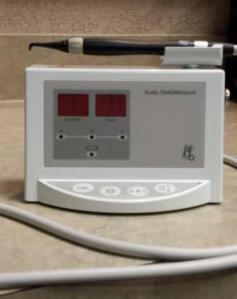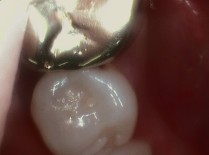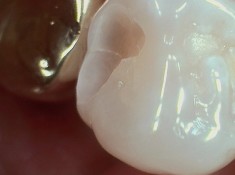Let me introduce you to one of the secret weapons we have in our arsenal of cavity-fighting weapons. This little warrior uses a laser beam to detect cavities at the most conservative level. A laser beam is used to detect changes happening before we can feel or see those changes happening. This little helper is designed to detect slight changes in the tooth structure. This little laser, used in conjunction with digital x-rays, often proves to be superior to the older method of using the “pointy poker” to find soft spots in the teeth. And it can be done without you, the patient, feeling the laser working. No pain, now that is a plus!
Folks, meet DIAGNOdent.

We have been using this tool for fighting cavities in our office for many years and the technology has been around since 2005. Along with our digital x-rays, we are better able to help our patients maintain a healthy mouth. The technology available to help you maintain your healthy smile keeps getting better and better.
What does it mean to you to have a cavity-fighter such as DIAGNOdent in your corner? It could mean less tooth pain and problems because we are able to detect and treat cavities before they become large and bothersome. As you may or may not know, cavities do not go away by themselves. We can’t brush them away. We can’t give them away or even wish them away. The only way to get rid of a cavity, or the decayed part of the tooth, is to remove it. We have to physically remove the area which has decayed and replace the open hole with a filling material. Another plus with earlier detection of decay means that you will spend less time and money at the dental office. It’s a win-win situation and we like win-win, are you with me?
The DIAGNOdent uses a laser to detect differences in healthy and unhealthy tooth by measuring degrees of fluorescence in your tooth structure. These readings are recorded in the chart and monitored.
00-10 Healthy Tooth Structure
11-20 Outer Enamel Changes (The enamel is the hard outer protective covering of your tooth.)
21-30 Inner Enamel Changes
30+ Dentin Changes (Dentin is softer than enamel and decay often moves more quickly when it burrows this deep into the tooth.)



The goal in our office is to keep your smile healthy and be able to do provide pain-free dentistry. Part of the whole picture is being able to educate our patients so that they are able to help decide how to keep themselves healthy and happy. A smile is a universal sign of happiness and we are so lucky to be able to help people keep their teeth and to be able to smile. Know that when you come in to see Dr. Alspaugh and the rest of the team, we will work to provide you the best dental experience by using up-to-date technology to help fight disease in your mouth.
Keep brushing and smiling!
